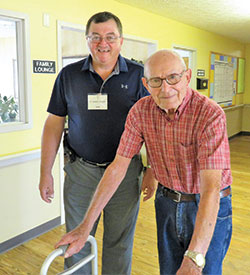Compassionate Visitors visit the elderly, accompany the dying

Compassionate Visitor volunteer Mike Fronckowiak, left, a member of St. Gabriel Parish in Connersville, walks on Aug. 3 with Earl Schneider, a resident he visits weekly at a nursing home in Connersville. (Submitted photo)
By Natalie Hoefer
Sometimes involvement in a ministry reveals an even deeper need beyond the one being met.
So it was for Barbara Davis-Hinkle of St. Gabriel Parish in Connersville, who started a nursing home ministry several years ago in her parish.
“We bring the Eucharist to the home‑bound and those in nursing homes every week, and we give Christmas and Easter gifts to the Catholic residents,” she explains. The ministry also arranges for the parish’s pastor, Father Dustin Boehm, to offer the sacraments at two local nursing homes.
But as she walked the halls of the nursing homes as a volunteer for her own ministry, “It became obvious that some residents were sitting alone with no one to visit them,” she says. “And then I noticed that a few were dying with no one to sit with them” in their final hours.
Davis-Hinkle “put the two scenarios together.” In May 2017, she began to develop a plan, and in March of this year, that plan came to fruition: a ministry called Compassionate Visitors.
‘They might know Jesus through us’
On the visiting side of the ministry, nurses at local senior homes keep Davis‑Hinkle informed of residents with few or no visitors. She then assigns one or two residents for each volunteer to visit weekly.
Currently, her team consists of 20 weekly visitors and 12 vigil-keepers—including volunteers who serve in both capacities—from both St. Gabriel and St. Bridget of Ireland Parish in Liberty.
They range in age from their 20s to their 80s. There are even four married couples who volunteer as husband and wife teams.
While grateful for the volunteers participating in the ministry, Davis-Hinkle says there is plenty of room for more, noting that the ministry currently has five residents waiting for a visitor to be assigned to them.
“We visit Catholics and non-Catholics alike,” she says. “It doesn’t seem to matter what religion they are, if you pray the Lord’s Prayer, they start to follow along. Even patients with dementia can follow along with some prayers.”
She recounts the story of one volunteer who visited a devout Baptist woman.
“There wasn’t a lot of conversation, but the visitor read Scripture to her,” Davis‑Hinkle recounts. “She said you could tell by the look in [the resident’s] eyes and how [the resident] would pat her hand that she really appreciated it.”
She shares about another visitor assigned to a non-verbal man with dementia.
“She sings hymns to him, or reads Scripture or poetry, or pushes him in his wheelchair,” says Davis-Hinkle. “He seems to be more alert since she started visiting him.”
Abigail McFeely, a St. Gabriel member of Compassionate Visitors, notes that “people light up when you walk into their room. Sometimes just a pat on the shoulder can mean the world to them.
“For me, going to the nursing home, I’ve become a better person,” she admits. “It makes me humble—I’m no different than them.”
The ministry has also provided opportunities to evangelize, Davis-Hinkle adds.
“I’ve seen instances of people who’ve been away from the Church 30, 40, 50 years,” she says. “We have the opportunity to ask them if they want a priest to visit. They have a chance to reconnect with their faith, and we have a chance to serve as a bridge to help them do that.
“We get to give people the love God wants them to receive. We may be the only form of God’s love they ever know. They might know Jesus through us.”
‘Like earthly angels leading them to holy angels’
Some of the volunteers serve as visitors and also as vigil-keepers when a resident is dying. Others volunteer as only vigil-keepers. Such ministry is not one to which all are called, says Compassionate Visitor Georgia Lucas, also a member of St. Gabriel.
But for those drawn to “walk people home, it is not upsetting,” she says. “It’s a beautiful act of mercy.”
For residents whose families are comfortable with the service, nurses contact Compassionate Visitors when they sense a patient is in their last days or hours in this life. A vigil is then scheduled with volunteers taking two‑hour shifts.
“It’s an honor to sit with them,” says Judy Sweney, who assists Davis-Hinkle in operating the ministry. “It’s inspiring. It’s a good feeling to know that you’re so close to something so beautiful.”
Davis-Hinkle agrees.
“You feel blessed to be with them so they know they’re not alone in their last minutes on Earth,” she says.
McFeely says keeping vigil “is like the hymn, ‘May the Holy Angels Lead You into Paradise,’ except we’re like earthly angels leading them to the holy angels.”
All Compassionate Visitors receive a one-day training and meet every other month for educational opportunities and to share stories.
Additionally, vigil-keepers receive a package of items to help them accompany the dying. The kit includes a St. Benedict cross, scapular, votive candle holder, holy water, rosary, Divine Mercy chaplet card and a handbook of prayers to pray for a person who is dying—for after her or she has died and for the family members.
Whether visiting the elderly, keeping vigil with the dying or both, says Davis‑Hinkle, “When you do service for others, you forget yourself. There’s something so uplifting about that. You gain a reward from the experience, maybe even more than the person you’re helping.”
(For more information on Compassionate Visitors, contact Barbara Davis-Hinkle at 765-825-9308, or Judy Sweney at 765‑825-6672.) †
Related: Serving seniors and seniors serving in central and southern Indiana
